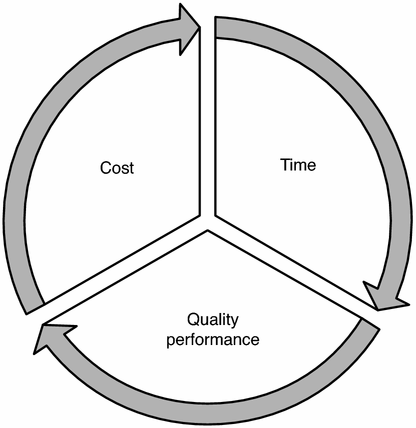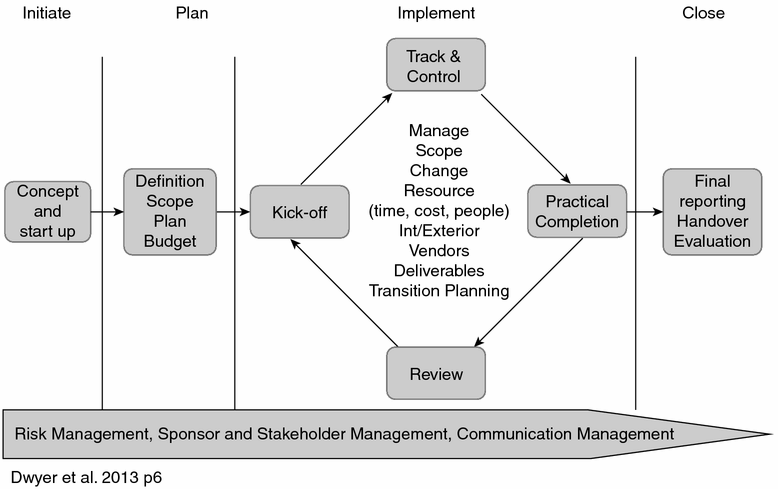- Project
‘A unique set of inter-related activities designed to produce a set of deliverables and achieve a defined goal within clearly defined time, cost and quality constraints’ (Dwyer, Liang, Thiessen & Martini, 2013, p. 20)
- 3D objective
Meeting quality performance or expectations within the timeframe and budget allowed

Figure 19.1 The 3D objective of a project. J. Dwyer, Z. Liang, V. Thiessen & A. Martini (2013). Project management in health and community services: Getting good ideas to work (p. 2). Sydney: Allen & Unwin.
Since a project is a one-off effort to achieve a specific purpose, which may not have been attempted before, project design and project management can be challenging. It is important that the common features of projects are well understood. There are many factors that undermine the success of a project. Some factors can be controlled by conducting proper and thorough project planning, building an efficient project management structure and engaging the right types of personnel, including project staff with the required project management competency and expertise.
- Project management
A systematic management process with techniques to bring people and resources together for a single purpose
Frameworks
Although projects are highly varied in focus, size and complexity, they move through a common basic life cycle: initiation, planning, implementation and closing. This project framework outlines the normal progression of projects from initiation to completion (Kloppenborg, 2009). Figure 19.2 shows the four-phase framework of the project life cycle.

Figure 19.2 Project life cycle. J. Dwyer, Z. Liang, V. Thiessen & A. Martini (2013). Project management in health and community services: Getting good ideas to work (p. 6). Sydney: Allen & Unwin.
However, it is worth bearing in mind that project development and management are not usually simple linear processes. There may be many cycles of planning, implementation, evaluation and variation (Dwyer et al., 2013). The phases included in the basic project framework are part of the joint project process and not truly separate. They tend to overlap and often lack clear boundaries. Moreover, projects do not generally proceed exactly as planned and can run backwards; for example, problems in the project-planning can force a rethink of the original concept. Therefore, ongoing monitoring – identifying problems or variations, modifying the plan and taking action – is a critical role for the project manager. Table 19.1 details possible steps to take during each of the four project phases.
| Project phases | Key steps |
|---|---|
| Initiate | Identify a problem or opportunity. Develop and scope initial concept. |
| Plan | Clarify the goals and define the scope (how big is it?). Determine how, when and by whom the project will be done. Determine resource requirements. Determine evaluation measures (how project success is judged). Finalise a project plan. |
| Implement | Carry out all tasks as detailed in the project plan. Check work progress regularly. Keep records and collect data necessary for project monitoring and evaluation. Develop interim project reports as per funding requirements. Manage people, stakeholders and risk. Monitor budget (expenses versus income). |
| Close | Complete evaluation. Develop final project report. Prepare for proper handover. Maintain final communications to sponsors, funding bodies and key stakeholders. Celebrate with staff for project learning and project success. |
Core components and development
A project has a clear goal to achieve, explicitly stated objectives, well-understood strategies to achieve them, well-defined benefits or changes that can be produced and measured, a specified timeline for producing all the benefits or changes, and well-defined resources to implement the strategies and produce the deliverables. Project-planning starts with defining problems to be solved, ways of solving the problems and the ultimate benefits of solving the problems. It is important that an evidence-based process should apply to the identification of problems and relevant solutions.
A rigorous needs analysis process plays a key role in designing a project that can ultimately address the proven problems by producing the desired outcomes via successful implementation and completion of the chosen strategies. It is also worth noting that before a project plan is completed, early consultation of key stakeholders, gaining organisational senior management support and brainstorming among the potential project team are all critical steps.
- Needs analysis
A comprehensive study or evaluation of the issues and needs of a particular situation
Project goal
A project goal is a statement of what the project will achieve in response to the problems that the project will address (Dwyer et al., 2013). For example, if an identified problem is high prevalence of type 2 diabetes within the 35–44 years age group in a specific council area, a project can be planned with an overall goal of reducing the prevalence of type 2 diabetes within a certain time period among the identified target group.
- Project goal
A statement of what the project will achieve in response to the problems and/or opportunities that the project will address
Project objectives
The immediate outcomes throughout the project before achieving the overall project goal can be called project objectives. Like goals, objectives are statements of what the project wants to achieve at a lower level and the intermediate benefits that the project needs to produce (Dwyer et al., 2013).
- Project objectives
Statements of what the project will achieve at a lower level and the intermediate benefits that the project needs to produce
Ultimately, the achievement of project objectives leads to the achievement of the overarching project goal. For example, in order to achieve a reduction in the prevalence of type 2 diabetes, a number of changes among the target population have to be brought about, such as adequate daily intake of vegetable and fruit, commitment to 30 minutes of daily physical activities, and overall body mass index reduction.
Project strategies
A project strategy constitutes a series of related actions designed to achieve the project objectives and ultimately contribute to attaining the broader project goal (Eagar, Garrett & Lin, 2001). Once the project goal and objectives are clear, providing guidance in what to achieve, the project designer needs to decide how to realise it. Using the above example, key strategies may be the promotion of good dietary habits through a media campaign and workshops, and organisation of regular physical activities for the target group. Although projects vary in size, achieving the project goal is normally not a one-step approach. Project teams need to complete many steps, monitoring the results of these steps, before the problems can be solved and project goal achieved.
- Project strategy
A collection of methods to achieve project goals
It is important to note that a project’s goal, objectives and strategies should be closely aligned to the problems that the project is going to solve. Therefore, the development of the goal, objectives and strategies is not a linear process. A project designer needs to ensure all the intermediate changes that are important to achieving the overarching goal can be produced by implementing all the strategies. Consequently, all the intermediate changes that strategies can produce are captured in the forms of objectives.
Project plan
Once the goal, objectives and strategies for a proposed project are clear, planning the activities, timing and resources needed to achieve them is the next step. There are many tools and methods for this, such as work breakdown structures and linear responsibility charts, which can make planning easier. To complete this step, the project team needs to carry out the following tasks, identified by Dwyer et al. (2013):
- Document all the key activities and associated tasks that have to be completed; the activities and tasks of a project need to be defined and broken down into manageable chunks; a mechanism for decomposing the project goals into manageable tasks to allow estimation of project time and costs to take place (Kliem, 2007).
- Put activities and tasks in the right sequence.
- Identify the resources required to complete each of the tasks.
- Explore the relationships and dependencies between the tasks.
- Estimate how long the project will take and any deadlines (or critical points) within the project.
The above steps can be time-consuming, requiring inputs from colleagues with various levels of expertise and experience, depending on the size and complexity of the project. Project strategies cannot work unless there is a clear action plan, with the necessary staff, resources and equipment at hand. Estimation also needs to take into consideration the additional time and resources required for pretest strategies, when these are considered necessary. For example, a project team developing a training workshop for a large population group could pretest it on a small sample to discover whether the workshop is successful and the materials used are relevant and appropriate. Modifications and revisions to the workshop and relevant materials may then be required before rolling it out to the target population group. These activities should be identified in the planning stages and written into the plan.
The simplest way to make a project plan is to start with the goals, strategies and deliverables, breaking them down using subheadings and expanding them in a list format. In project management terms this is called creating a work breakdown structure, ‘a tool that the project team uses progressively to divide the work of a project into smaller and smaller pieces’ (Kloppenborg, 2009, p. 142) and a mechanism for decomposing the project goals into manageable tasks to allow estimation of project time and costs to take place (Kliem, 2007).
- Deliverables
The products, services or outcomes provided as the result of a project
- Work breakdown structure
‘A tool that the project team uses progressively to divide the work of a project into smaller and smaller pieces’ (Kloppenborg, 2009, p. 142)
Stay updated, free articles. Join our Telegram channel

Full access? Get Clinical Tree


